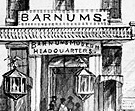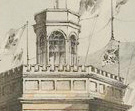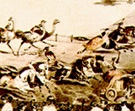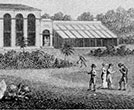|
Humanities and Social Sciences Library > Collections & Reading Rooms > Print Collection > MOVING UPTOWN Section IV (Entertainment, including theaters and the Crystal Palace)Entertainment An English visitor commented that New York had the "air of a town
sacrificed to trade." Merchants may have appeared more concerned about
their financial worth than with cultivating their minds and souls, yet
New Yorkers liked to be entertained, whether at the circus, the pleasure
garden, the theatre, the music hall, or the opera. Nathaniel Currier (American lithographic firm, 1835–57) When war with England threatened, Castle Clinton, a circular fort of
red sandstone, was built in 1811 on landfill near the west edge of the
Battery. Never used as a fort, it was ceded in 1823 to the city, renamed
Castle Garden, and served as an entertainment hall for more than 30 years.
Although Castle Garden was used primarily for receptions and recitals,
occasionally it was the setting for more momentous events, including a
rally in 1850 to support the Union and Henry Clay's compromise resolutions
in Congress. From 1855 to 1890, Castle Garden was the primary point of
entry on the East Coast for immigrants to the United States. Nathaniel Currier (American lithographic firm, 1835–57) Though in 1830 the city ruled supreme in the nation's commercial, industrial,
and financial endeavors, New York lagged behind in cultural and artistic
achievements. By mid-century, however, New York had caught up with Boston
and Philadelphia. New York audiences turned out in droves for Jenny Lind
when she performed at Castle Garden as part of a two-year tour organized
by P. T. Barnum. This print records her New York debut in the autumn of
1850. Tickets went for fantastic prices; Genin, whose hat shop is visible
in New York from the Steeple of St. Paul's Church, paid $225 at
auction for a ticket, considerably more than the $7 printed on this ticket
for a later, November performance. The "take" for the opening night was
$26,238; the singer contributed her share of the proceeds, $12,600, to
New York charities. Nagel & Weingaertner (American lithographic firm, 1849–57) The American Museum, originally the Tammany Museum located near the
present City Hall, housed a collection of Indian artifacts, a few prints,
farming equipment, and a live mountain lion. Relocated in 1830 to the corner
of Broadway and Ann as Scudder's Museum, it eventually closed and was purchased
by P. T. Barnum in 1841. Renaming it the American Museum, Barnum made it
a success, offering curiosities of art and nature, including fleas, jugglers,
the "Feejee mermaid," and Tom Thumb (Charles Stratton). Anonymous
Anonymous Nathaniel Currier (American lithographic firm, 1835–57) A popular form of entertainment since colonial times, circuses in the
early 19th century were performed for weeks or months in temporary buildings
and pleasure gardens (Vauxhall, Niblo's), though the introduction of tents
made them less dependent on long city engagements. Late in 1834 a number
of menageries consolidated to form the Zoological Institute at 37 Bowery;
Isaac Van Amburgh, one of the country's first wild animal trainers, performed
there. Sarony and Major (American lithographic firm, 1846–57)
Geib and Jackson (American lithographic firm, 1849–58) Tinted lithograph Franconi's Hippodrome. 1853 Letterpress The playbill for Franconi's Hippodrome, which lasted only two seasons
at Madison Square, offered an intriguing variety of circus acts, from "La
Trapaze" and "La Course Greque" to "La Perche Equipoise" and a "Contest
Between Two War Chariots." Anonymous New Yorkers enjoyed going to the theatre. One New Yorker observed in
the mid-1820s that "the lady considered herself as being ill-used by her
husband, if not conveyed at least once a week to a play-house." Park Theatre
(1798; burned in 1820; reopened 1821), visible on the right in Klinckowström's
view of City Hall , was perhaps the most prestigious and influential. Some
of the most accomplished actors and actresses from England performed there,
but the Park also nurtured native-born talent, and introduced New York
audiences to foreign-language operas. The Chatham Theatre, also on Park
Row, between Duane and Pearl, opened in 1824 to give the Park Theatre its
first serious competition, though the Chatham catered more to a working-class
crowd. Rawdon, Wright and Co. (American engraving firm, 1828–31) Like the Chatham Theatre, the Bowery was patronized by a working-class
audience. Many of the newer and larger theatres (Bowery, Vauxhall Garden
Theatre, Niblo's Garden and Theatre) were concentrated on two of the city's
central thoroughfares –Broadway and the Bowery. Sarony and Major (American lithographic firm, 1846–57) A bandmaster and violinist with the New York Philharmonic, Allen Dodworth
opened a dancing school at 402 Broadway in 1842; other studios were located
at 681 Fifth Avenue (once a temporary site for the Metropolitan Museum
of Art) and at 12 East 49th Street. Dodworth, and later his nephew, believed
that proper dance technique and etiquette, as presented in his dance classes
and his book, Dancing and Its Relation to Education and Social Life,
could help refine society. William Satchwell Leney (American, b. England, 1769–1831)
Sperry's Garden, on Bowery Lane. About 1800 Anonymous A Swiss physician, Jacob Sperry settled in New York in 1748 and purchased what was then pasture land (now Lafayette and Astor Place), where he grew flowers and hothouse plants. A mile from the edge of the city, Sperry's gardens were a charming destination for a weekend stroll. Sperry sold his gardens in 1804 to John Jacob Astor, who then leased the property to a Frenchman named Delacroix. Delacroix transformed Sperry's property into the fashionable Vauxhall Garden, where New Yorkers could eat, drink, socialize, and be entertained by band music and, in the evenings, by fireworks and theatrical events. Vauxhall Garden's days were numbered, however. With real estate values
skyrocketing on nearby Bond, Bleecker, and Great Jones streets, when Delacroix's
lease was up in 1825, Astor cut a broad street through the property to
create Lafayette Place, reducing the garden to half its original size.
Astor realized a great profit for the lots on Lafayette Place, the site
of La Grange Terrace (Colonnade Row). Anonymous In 1823, the Irish impresario William Niblo purchased Columbian Garden,
as it was originally called, and added the Sans Souci Theatre, a saloon,
and a hotel to the landscaped grounds. Niblo's opened in 1829. The fashionable
entertainment center could accommodate 3,000 spectators, who came to see
such legendary performers as Joseph Jefferson, Charles Kean, Edwin Forrest,
Charlotte Cushman, and Adelina Patti. The Philharmonic in its early years
performed at Niblo's, and it was said that the polka was introduced there
in 1844. Anonymous (possibly Sarony, Major & Knapp) Theatres had clustered primarily around Park Row, Broadway between City
Hall and Houston, and on the lower Bowery, but during the 1860s and 1870s,
Union Square was the site of the city's first theatre district. A few years
earlier, in July 1858, the Palace Garden, a "place of open-air recreation" in
the tradition of earlier "pleasure gardens," such as Vauxhall and Niblo's,
had opened on 14th Street near Sixth Avenue. Augustus Fay (American, b. about 1824, active 1848–60)
Crystal Palace in New York. About 1853 Charles Gildemeister (German, 1820–1869) and George Carstensen (Danish,
1812–1857) Inspired by the Crystal Palace of London, the New York Crystal Palace
for the Exhibition of the Industry of All Nations was built for the 1853
World's Fair on a site behind the Croton Reservoir, between Fifth and Sixth
Avenues on 42nd Street (today's Bryant Park). The architects, George Carstensen
and Charles Gildemeister, designed the building as a Greek cross, crowned
by a dome 100 feet in diameter, constructed of iron and glass, with wood
used only for the floors, doors, and sashes. The so-called "fireproof" building
burned in 15 minutes on October 5, 1858. William Wellstood (American, b. Scotland, 1819–1900) From 300 feet in the air, on the third landing of the Latting Observatory facing 42nd Street between Fifth and Sixth avenues, a spectator could gaze upon the Crystal Palace and the Croton Reservoir (the site of Bryant Park and the future New York Public Library), down the island and past the tip of Manhattan on into the distance to Queens, Brooklyn, Staten Island, and New Jersey. The Latting Observatory, an octagonal tower of timber braced with iron, was equipped with the first passenger elevator in New York City, a steam-powered lift that ascended to the first and second landings. This structure was shorter-lived than the Crystal Palace; completed in 1853, it burned in 1856. George Templeton Strong, whose diaries, like Philip Hone's, record life in 19th-century New York, wrote in 1850, "How this city marches northward!" "The progress of 1835 and 1836 was nothing to the luxuriant rank growth of this year." At about the same time, the Evening Post commented, "the rapid growth of New York has ceased to be a matter of astonishment." However, the area around Fifth and Madison in today's midtown was still sparsely settled, and until about 1865 there was concern about the future of Fifth Avenue above 42nd Street. There were a number of institutions above 42nd which affected Fifth Avenue's standing as a fashionable thoroughfare: the Colored Orphans Asylum on Fifth between 43rd and 44th, the New York School for the Deaf on 50th Street, St. Luke's Hospital on 51st and 52nd streets, and, especially disturbing, livestock pens and a slaughterhouse (though most were located on the West Side and the Lower East Side, one yard was at Lexington Avenue and 57th Street), garbage dumps, and shanty towns. One census reported over 10,000 squatters living north of 42nd Street, in communities such as "Dutch Hill" between 38th and 44th streets along the East River, in the area that would become Central Park, and on the Upper West Side. |




